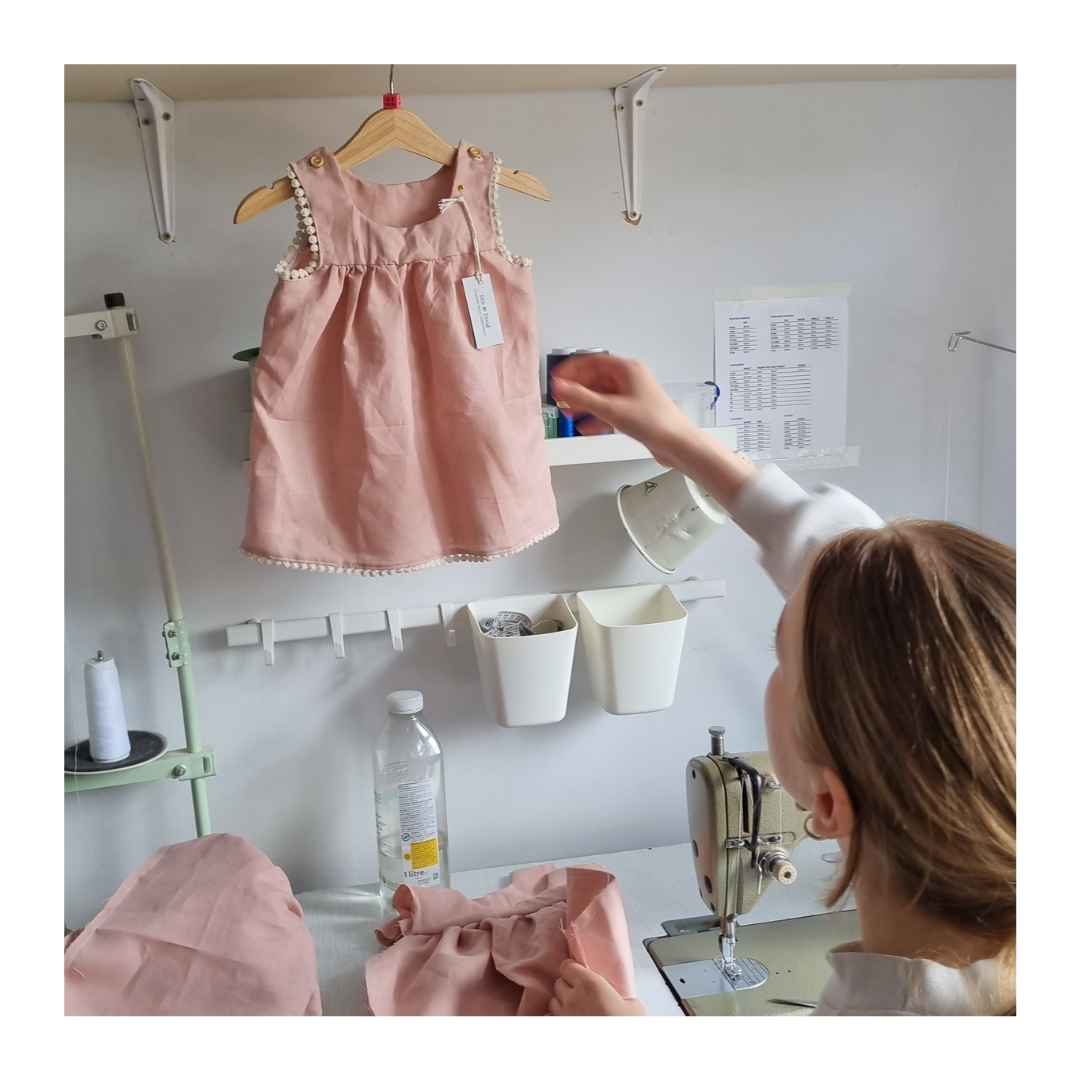Author: Natalie Wilkinson Edwards
17 - 06 - 2022
Confession time. In years gone by, I haven’t always bought clothes with huge consideration as to where they come from. These days, I am far more conscious and make an effort to buy second hand or from sustainable brands as far as possible.
I like to think things are getting better; more people seem to be making an effort, like me. During the pandemic many people have become more willing to make eco friendly changes in their day to day lives. It goes without saying there is still a long way to go.
I’m not sure many of us think about where the actual fabric comes from when we treat ourselves (or our children) to an item of clothing. Emma Moore, owner of Dot and Doug, prides herself on using deadstock and/or organic fabrics. Each piece is lovingly created here in the U.K. Everything is plastic free; even the elastic is eco friendly.
I imagine some of you reading this aren’t familiar with the idea of deadstock material. Essentially, it’s left over fabric that can't be used for its original purpose or order fulfilment.

There is an incredible amount of waste in the fashion industry. As with all lines of business, generally you pay for what you get. Fast fashion usually means buying cheap, wearing it once of twice, then said item will lurk in the back of your wardrobe forever more. If you’re lucky, it might end up in a charity shop - or perhaps the bin. I am flabbergasted about the waste that goes on in the UK, let alone globally. About £140 million* worth of used clothing ends up in landfill each year. It’s a figure I can’t get my head around.
Many manufactures and fashion houses are most interested in financial gain and the prices, fabric and labour reflect that. I am delighted to discover there is a wave of ‘deadstock designers’ coming through the ranks.
Speaking with Veronika Guardi, owner of the luxury, sustainable brand ‘Guardi’ - she explains her belief that some old fashion values need to come back into play. Buying one off, timeless pieces that can transition throughout the seasons can make a huge difference to our wardrobes and the planet.
Both Dot and Doug and Guardi ensure that any left over fabrics are put to good use. Both have a great selection of accessories that ensure that nothing goes to waste.

What I loved about speaking with both women, is the way in which their design process works. This morning when I called, Veronika was looking through a selection of deadstock swatches. From there, she will choose the fabrics that lend themselves to her designs and create something wonderful. Emma often posts pictures of fabrics she has and asks her many followers on social media what they they would like to see made. Both companies create limited edition pieces, which makes the luxury feel even more, well, luxurious. Once the fabric has gone… it’s gone!
I wanted to speak to someone higher up the fabric food chain - the fabric suppliers. AmoThreads is an excellent retailer that provides 100% deadstock materials, to mostly small independent businesses or individuals. Robert from AmoThreads shared his amazement at the waste that is still happening; ‘It is amazing how much deadstock there is available due to over production, poor forecasting, rejected fabrics, mills going out of business, etc’.
AmoThread’s mission is to reduce the amount of fabrics that is sitting in warehouses, waiting to be chucked. The only time AmoThread throws away fabric is if it’s faulty. ‘It all eventually goes,’ Robert says. It is refreshing to learn that they hold on to the fabric till the end. Each thread gets to meet its destiny.
In the depths of my research, I discovered WRAP. WRAP is an incredible non governmental organisation that is quite literally, on a mission to save the world. So far they’re doing a pretty amazing job and are responsible for a lot of positive changes we see from day to day. They have created a new, ground breaking initiative - Textiles 2030 - which is a ‘new sustainable textile agreement changing clothes and homeware for good to halve their climate impact.’**
Their Signatory Pack packs a punch within the first few pages of reading.
‘In the UK we buy more clothes per person than any other country in Europe with an industry worth £32 billion...yet almost one third of the contents of UK wardrobes is not worn.’ It’s shameful, isn’t it?
Essentially, creating fabric uses a huge amount of water, energy and raw materials. Going forward this simply cannot be sustained. It really is alarming how naive so many of us seem to be (myself included) at just how critical it is that we really start taking more responsibility about what we are buying, and where from.
So what can we do?
I remember being taught, ‘reduce, reuse, recycle’. It really is as simple as that. Invest in some timeless pieces that you can style out time and time again. Yes, it may cost a little more but it will be made beautifully and last you a lifetime. For other times, when the budget doesn’t allow such luxuries (goodness knows times are tough right now) buy second hand. I wandered into a vintage shop in a nice area of Berkshire at the weekend and the standard of clothing was unbelievable.
I never thought I would summarise a blog with a statement written by an MP - but Rebecca Pow (Environment Minister for the Department of Environment, Food and Rural Affairs) conveys the situation in a very grown up way.
“Thousands of tonnes of unwanted clothes and textiles end up in landfill and incineration each year, wasting precious natural resources. That is why we must shift away from this ‘take, make, use, throw’ approach to a more circular system where clothes are kept in use and re-used, recycled fibres are used in new products and the climate and water impacts of the sector are reduced. Textiles 2030 will help drive this transformation, to shift to greater circularity and innovation in the UK – and help in our mission to build back greener from the COVID pandemic.”
In a nutshell. Get the best of what you can afford. Wear it loads. Shop smart, shop sustainable, make a change.
*WRAP Study - 2030 Textile Plan
** https://wrap.org.uk/taking-action/textiles/initiatives/textiles-2030

